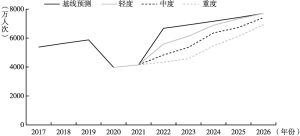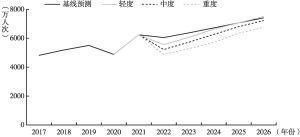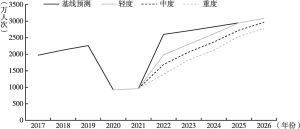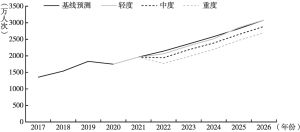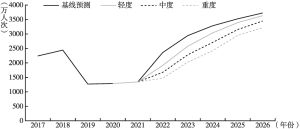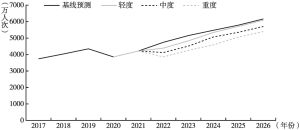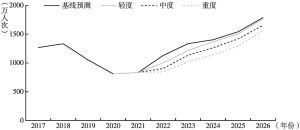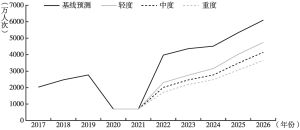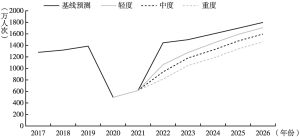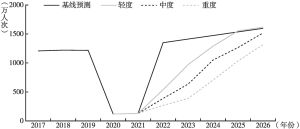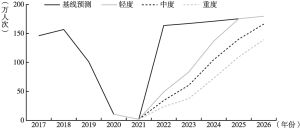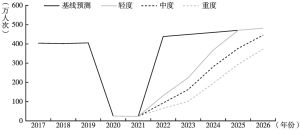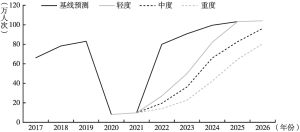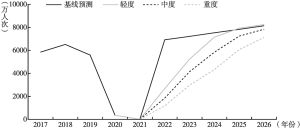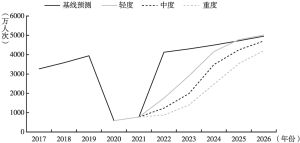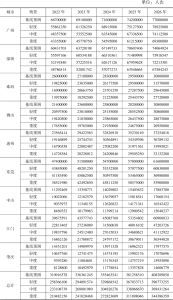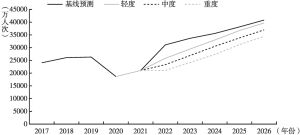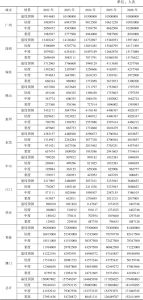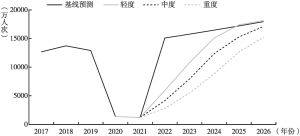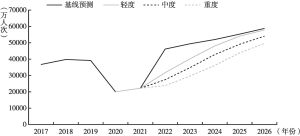摘要
本报告利用基于情景分析的德尔菲专家预测法对粤港澳大湾区未来五年(2022~2026年)的国内和入境旅游需求进行了预测。本报告首先利用ARDL-ECM模型生成基线预测,然后邀请了8位专家根据新冠肺炎疫情对旅游需求的影响程度对基线预测进行调整,生成了三种情景预测。根据基线预测,在不存在新冠肺炎疫情的情况下,粤港澳大湾区的游客需求将稳步增长,到2026年增长至5.88亿人次;然而,鉴于新冠肺炎疫情对粤港澳大湾区旅游需求的影响持续存在,根据情景预测,在疫情对旅游需求产生轻度、中度和重度影响的情况下,粤港澳大湾区的游客总数将分别在2023年、2024年和2025年恢复到疫情发生前(2019年)的水平;国内旅游需求已呈现逐渐恢复趋势,入境旅游需求的恢复速度相对缓慢,但预计在疫情稳定后快速增长。根据疫情影响程度做出的情景预测将为粤港澳大湾区旅游业在疫情防控常态化时期的行业复苏、焕新和发展提供重要的理论指导和参考依据。
作者
张瀚元 ,博士,香港理工大学酒店及旅游业管理学院研究助理教授,研究方向为旅游经济学。
刘营 ,香港理工大学酒店及旅游业管理学院研究助理,研究方向为旅游需求预测。
宋海岩 ,博士,香港理工大学酒店及旅游业管理学院副院长,首席教授,研究方向为旅游经济学及计量经济学。
- 广东省统计局,2021,《广东统计年鉴》,广东统计信息网,http://stats.gd.gov.cn/gdtjnj/。
- Chen,Y.,H.Kang,and T.Yang. 2007. “A Study on the Impact of SARS on the Forecast of Visitor Arrivals to China.” Journal of Asia-Pacific Business 8:31-50.
- Choe,Y.,J.Wang,and H.Song. 2021. “The Impact of the Middle East Respiratory Syndrome Coronavirus on Inbound Tourism in South Korea toward Sustainable Tourism.” Journal of Sustainable Tourism 1:1-17.
- Chu,F. 2008. “A Fractionally Integrated Autoregressive Moving Average Approach to Forecasting Tourism Demand.” Tourism Management 29:79-88.
- Durbarry,R.,and M.T.Sinclair. 2003. “Market Shares Analysis:The Case of French Tourism Demand.” Annals of Tourism Research 30:927-941.
- Fotiadis,A.,S.Polyzos,and T.Huan. 2021. “The Good,the Bad and the Ugly on COVID-19 Tourism Recovery.” Annals of Tourism Research 87:103117.
- Ghaderi,Z.,A.P.Mat Som,and J.C.Henderson. 2015. “When Disaster Strikes:The Thai Floods of 2011 and Tourism Industry Response and Resilience.” Asia Pacific Journal of Tourism Research 20:399-415.
- Huang,J.H.,and J.C.H.Min. 2002. “Earthquake Devastation and Recovery in Tourism:The Taiwan Case.” Tourism Management 23:145-154.
- Jiao,E.X.,and J.L.Chen. 2019. “Tourism Forecasting:A Review of Methodological Developments over the Last Decade.” Tourism Economics 25:469-492.
- Kim,Y.R.,A.Liu,J.Stienmetz,and Y.Chen. 2022. “Visitor Flow Spillover Effects on Attraction Demand:A Spatial Econometric Model with Multisource Data.” Tourism Management 88:104432.
- Kourentzes,N.,A.Saayman,P.Jean-Pierre,D.Provenzano,M.Sahli,N.Seetaram,and S.Volo. 2021. “Visitor Arrivals Forecasts Amid COVID-19:A Perspective from the Africa Team.” Annals of Tourism Research 88:103197.
- Lee,S.,C.Oh,and J.T.O’Leary. 2005. “Estimating the Impact of the September 11 Terrorist Attacks on the US Air Transport Passenger Demand Using Intervention Analysis.” Tourism Analysis 9:355-361.
- Lin,V.S.,and H.Song. 2015. “A Review of Delphi Forecasting Research in Tourism.” Current Issues in Tourism 18:1099-1131.
- Lin,V.S. 2013. “Improving Forecasting Accuracy by Combining Statistical and Judgmental Forecasts in Tourism.” Journal of China Tourism Research 9:325-352.
- Lin,V.S.,P.Goodwin,and H.Song. 2014. “Accuracy and Bias of Experts’ Adjusted Forecasts.” Annals of Tourism Research 48:156-174.
- Liu,A.Y.,L.Vici,V.Ramos,S.Giannoni,and A.Blake. 2021. “Visitor Arrivals Forecasts Amid COVID-19:A Perspective from the Europe Team.” Annals of Tourism Research 88:103182.
- Pesaran,M.H.,Y.Shin,and R.J.Smith. 2001. “Bounds Testing Approaches to the Analysis of Level Relationships.” Journal of Applied Econometrics 16:289-326.
- Polyzos,S.,A.Samitas,and A.E.Spyridou. 2021. “Tourism Demand and the COVID-19 Pandemic:An Lstm Approach.” Tourism Recreation Research 46:175-187.
- Qiu,R.T.R.,D.C.Wu,V.Dropsy,S.Petit,S.Pratt,and Y.Ohe. 2021. “Visitor Arrivals Forecasts Amid COVID-19:A Perspective from the Asia and Pacific Team.” Annals of Tourism Research 88:103155.
- Saha,S.,and G.Yap. 2013. “The Moderation Effects of Political Instability and Terrorism on Tourism Development:A Cross-Country Panel Analysis.” Journal of Travel Research 53:509-521.
- Sanders,N.R.,and L.P.Ritzman. 2001. “Judgmental Adjustment of Statistical Forecasts.” In Principles of Forecasting:A Handbook for Researchers and Practitioners,edited by Armstrong,J.,pp.405-416.Boston:Kluwer Academic Publishers.
- Shi,W.,and K.X.Li. 2017. “Impact of Unexpected Events on Inbound Tourism Demand Modeling:Evidence of Middle East Respiratory Syndrome Outbreak in South Korea.” Asia Pacific Journal of Tourism Research 22:344-356.
- Smeral,E. 2010. “Impacts of the World Recession and Economic Crisis on Tourism:Forecasts and Potential Risks.” Journal of Travel Research 49:31-38.
- Song,H.,and G.Li. 2008. “Tourism Demand Modelling and Forecasting—A Review of Recent Research.” Tourism Management 29:203-220.
- Song,H.,and S.F.Witt. 2003. “Tourism Forecasting:The General-to-Specific Approach.” Journal of Travel Research 42:65-74.
- Song,H.,and S.Lin. 2010. “Impacts of the Financial and Economic Crisis on Tourism in Asia.” Journal of Travel Research 49:16-30.
- Song,H.,B.Z.Gao,and V.S.Lin. 2013. “Combining Statistical and Judgmental Forecasts Via a Web-Based Tourism Demand Forecasting System.” International Journal of Forecasting 29:295-310.
- Song,H.,G.Li,S.F.Witt,and B.Fei. 2010a. “Tourism Demand Modelling and Forecasting:How Should Demand Be Measured?.” Tourism Economics 16:63-81.
- Song,H.,R.T.R.Qiu,and J.Park. 2019. “A Review of Research on Tourism Demand Forecasting:Launching the Annals of Tourism Research Curated Collection on Tourism Demand Forecasting.” Annals of Tourism Research 75:338-362.
- Song,H.,S.F.Witt,and G.Li. 2008. The Advanced Econometrics of Tourism Demand. New York:Routledge.
- Song,H.,S.Lin,S.F.Witt,and X.Zhang. 2011. “Impact of Financial/Economic Crisis on Demand for Hotel Rooms in Hong Kong.” Tourism Management 32:172-186.
- Song,H.,S.Lin,X.Zhang,and Z.Gao. 2010b. “Global Financial/Economic Crisis and Tourist Arrival Forecasts for Hong Kong.” Asia Pacific Journal of Tourism Research 15:223-242.
- Taylor,J.W. 2003. “Exponential Smoothing with a Damped Multiplicative Trend.” International Journal of Forecasting 19:715-725.
- Woosnam,K.M.,and H.Kim. 2014. “Hurricane Impacts on Southeastern United States Coastal National Park Visitation.” Tourism Geographies 16:364-381.
- Wu,D.C.,Z.Cao,L.Wen,and H.Song. 2020. “Scenario Forecasting for Global Tourism.” Journal of Hospitality & Tourism Research 45:28-51.
- Yeoman,I.,M.Galt,and U.McMahon-Beattie. 2005. “A Case Study of How Visitscotland Prepared for War.” Journal of Travel Research 44:6-20.
- Ying,T.,K.Wang,X.Liu,J.Wen,and E.Goh. 2021. “Rethinking Game Consumption in Tourism:A Case of the 2019 Novel Coronavirus Pneumonia Outbreak in China.” Tourism Recreation Research 46:304-309.
- Zhang,H.,and J.Lu. 2022. “Forecasting Hotel Room Demand Amid COVID-19.” Tourism Economics 28:200-221.
- Zhang,H.,H.Song,L.Wen,and C.Liu. 2021. “Forecasting Tourism Recovery Amid COVID-19.” Annals of Tourism Research 87:103149.


